Several passengers who were seriously injured during severe turbulence on a Singapore Airlines flight earlier this week will need spinal surgery, according to a Bangkok hospital. The turbulence, which occurred over the Andaman Sea, left one passenger dead and 20 others in intensive care.
A spokesperson for Samitivej Srinakarin Hospital, where most of the 104 injured were treated, confirmed that other hospitals have been asked to provide their top specialists to assist in the treatments. “We have received tremendous support from local hospitals,” he told the Associated Press on condition of anonymity.
Dr. Adinun Kittiratanapaibool, the hospital’s director, stated in a news conference that none of the 20 patients in intensive care were in life-threatening condition. “The patients include six Britons, six Malaysians, three Australians, two Singaporeans, and individuals from Hong Kong, New Zealand, and the Philippines,” he said.
Passengers described the terrifying experience of items and people being thrown around the cabin. Amelia Lim, a 43-year-old Malaysian, recalled, “I was so afraid… There was blood on the floor and on the people.”
The Boeing 777, en route from London’s Heathrow Airport to Singapore, experienced a sudden descent of about 6,000 feet in three minutes, prompting an emergency diversion to Thailand. Thai authorities indicated that the British man who died may have suffered a heart attack during the ordeal.
Hospital director Adinun detailed the injuries, noting that 22 patients had spinal or spinal cord damage, six had skull or brain injuries, and 13 had other serious injuries. Seventeen surgeries have been performed so far, including nine spinal surgeries.
Passengers were transported to Singapore on a special flight arranged by Singapore Airlines for those uninjured or with minor injuries. Experts have highlighted the importance of following safety instructions during turbulence, especially the use of seatbelts.
Anita Mendiratta, a tourism and aviation expert based in London, emphasized, “When there is turbulence, items in the overhead compartments can become hazardous.”
The incident underscores the dangers of clear air turbulence, which accounted for a significant portion of commercial airline accidents according to reports by the U.S. National Transportation Safety Board and the Federal Aviation Administration.
Despite the alarming experience, the hospital remains focused on the recovery of those injured, with ongoing surgeries and assessments to determine the long-term impact on patients’ health.






